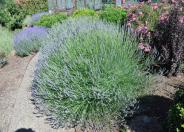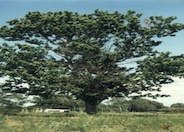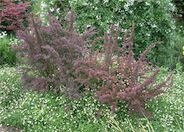
Common name:Cedar, Atlas 'Weeping Blue'
Botanical name:Cedrus atlantica 'Glauca Pendula'
This large, slow-growing conifer exhibits weeping growth form. Its golden leaves are 1" in size, and it also requires full sun in order to best develop its color. It serves as an excellent specimen or rock garden subject. This plant is fire-prone! Please use caution when planting near your home.

Common name:Lavender, Provence Blue
Botanical name:Lavandula X intermedia 'Provence'
With tall 24"-30" stems, 'Provence' has true, lavender colored flowers that are fragrant and excellent for cutting. It flowers in early June and has large, gray green leaves.

Common name:Box Elder
Botanical name:Acer negundo
The Boxelder is a deciduous, fast growing tree that attains heights of 40'-60'. It is native to California's streambanks and valleys below 6000'. The leaves have a beautiful, yellow fall color. This Acer is found throughout North America and is the most common of the Maples.
-Cornflower Farms

Common name:Redwood, Coast Redwood
Botanical name:Sequoia sempervirens
This fast-growing, aromatic tree has soft, dark green foliage with long needles appearing in flat sprays and brown, barrel-shaped cones that appear after 1 year. Its soft, red-brown bark is fiberous and furrowed. Particularly after mechanical damage, this tree will stump sprout to form new, young trees around the stump. Avoid planting in areas of high foot traffic. This plant is fire-prone! Please use caution when planting near your home.

Common name:Japanese Barberry, Red-Leaf
Botanical name:Berberis thunbergii 'Atropurpurea'
A thorny, deciduous shrub growing 4-6' high and as wide, Red Japanese Barberry can be contained with some light pruning in winter. Its purplish-red leaves contrast beautifully against a dark green background. It prefers full sun and regular watering, more in hot summer months. This is a great barrier plant.
Sustainable Fertilization
If you mulch heavily as recommended in the compost and mulch fact sheets you should not need traditional fertilization. Sustainable landscapes fertilize themselves as soil organisms break down and recycle the dropped leaves into nutrients.
Click in the green box for more information
| Designer: Solid Ground Landscape | Botanical Beauty |
Photographer: GardenSoft |
Soils and Compost:
Physical weed control, including mulching, or hand removal protects the watershed from harmful chemicals.
Integrated Pest Management:
Remove irrigation water and fertilizer from areas where you don't want weeds to grow.

